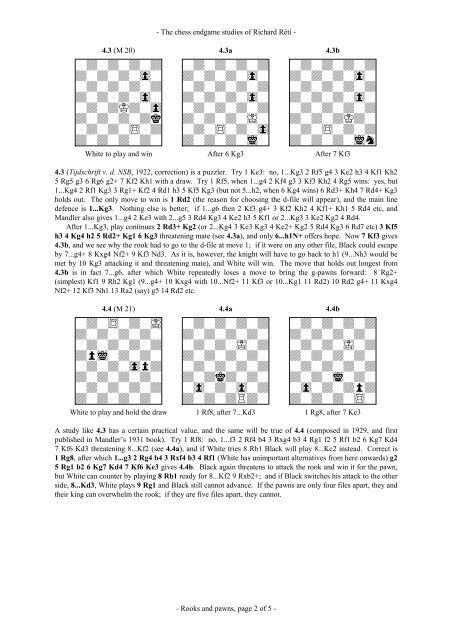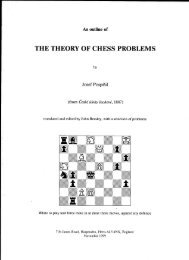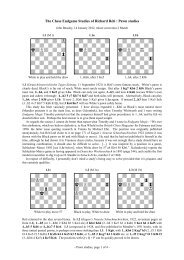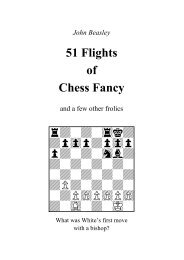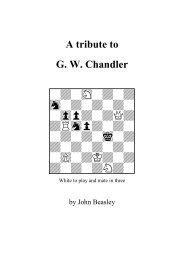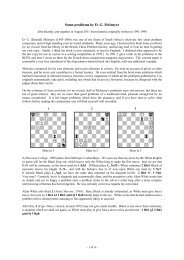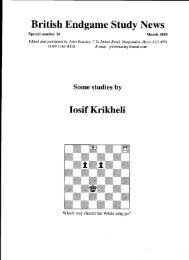The Chess Endgame Studies of Richard Réti - JSB
The Chess Endgame Studies of Richard Réti - JSB
The Chess Endgame Studies of Richard Réti - JSB
You also want an ePaper? Increase the reach of your titles
YUMPU automatically turns print PDFs into web optimized ePapers that Google loves.
- <strong>The</strong> chess endgame studies <strong>of</strong> <strong>Richard</strong> <strong>Réti</strong> -<br />
4.3 (M 20) 4.3a 4.3b<br />
wdwdwdwd wdwdwdwd wdwdwdwd<br />
dwdwdw0w dwdwdw0w dwdwdw0w<br />
wdwdwdwd wdwdwdwd wdwdwdwd<br />
dwdwdw0w dwdwdw0w dwdwdw0w<br />
wdwdKdw0 wdwdwdwd wdwdwdwd<br />
dwdwdwdk dwdwdwIw dwdwdKdw<br />
wdwdw$wd wdw$wdw0 wdw$wdwd<br />
dwdwdwdw dwdwdwiw dwdwdwin<br />
White to play and win After 6 Kg3 After 7 Kf3<br />
4.3 (Tijdschrift v. d. NSB, 1922, correction) is a puzzler. Try 1 Ke3: no, 1...Kg3 2 Rf5 g4 3 Ke2 h3 4 Kf1 Kh2<br />
5 Rg5 g3 6 Rg6 g2+ 7 Kf2 Kh1 with a draw. Try 1 Rf5, when 1...g4 2 Kf4 g3 3 Kf3 Kh2 4 Rg5 wins: yes, but<br />
1...Kg4 2 Rf1 Kg3 3 Rg1+ Kf2 4 Rd1 h3 5 Kf5 Kg3 (but not 5...h2, when 6 Kg4 wins) 6 Rd3+ Kh4 7 Rd4+ Kg3<br />
holds out. <strong>The</strong> only move to win is 1 Rd2 (the reason for choosing the d-file will appear), and the main line<br />
defence is 1...Kg3. Nothing else is better; if 1...g6 then 2 Kf3 g4+ 3 Kf2 Kh2 4 Kf1+ Kh1 5 Rd4 etc, and<br />
Mandler also gives 1...g4 2 Ke3 with 2...g5 3 Rd4 Kg3 4 Ke2 h3 5 Kf1 or 2...Kg3 3 Ke2 Kg2 4 Rd4.<br />
After 1...Kg3, play continues 2 Rd3+ Kg2 (or 2...Kg4 3 Ke3 Kg3 4 Ke2+ Kg2 5 Rd4 Kg3 6 Rd7 etc) 3 Kf5<br />
h3 4 Kg4 h2 5 Rd2+ Kg1 6 Kg3 threatening mate (see 4.3a), and only 6...h1N+ <strong>of</strong>fers hope. Now 7 Kf3 gives<br />
4.3b, and we see why the rook had to go to the d-file at move 1; if it were on any other file, Black could escape<br />
by 7...g4+ 8 Kxg4 Nf2+ 9 Kf3 Nd3. As it is, however, the knight will have to go back to h1 (9...Nh3 would be<br />
met by 10 Kg3 attacking it and threatening mate), and White will win. <strong>The</strong> move that holds out longest from<br />
4.3b is in fact 7...g6, after which White repeatedly loses a move to bring the g-pawns forward: 8 Rg2+<br />
(simplest) Kf1 9 Rh2 Kg1 (9...g4+ 10 Kxg4 with 10...Nf2+ 11 Kf3 or 10...Kg1 11 Rd2) 10 Rd2 g4+ 11 Kxg4<br />
Nf2+ 12 Kf3 Nh1 13 Ra2 (say) g5 14 Rd2 etc.<br />
4.4 (M 21) 4.4a 4.4b<br />
wdw$wdwI wdwdwdwd wdwdwdwd<br />
dwdwdwdw dwdwdwdw dwdwdwdw<br />
wdwdwdwd wdwdwIwd wdwdwIwd<br />
dpiwdwdw dwdwdwdw dwdwdwdw<br />
wdwdw0pd wdwdwdwd wdwdwdwd<br />
dwdwdwdw dwdkdwdw dwdwiwdw<br />
wdwdwdwd w0wdw0wd w0wdwdpd<br />
dwdwdwdw dwdwdRdw dwdwdw$w<br />
White to play and hold the draw 1 Rf8, after 7...Kd3 1 Rg8, after 7 Ke3<br />
A study like 4.3 has a certain practical value, and the same will be true <strong>of</strong> 4.4 (composed in 1929, and first<br />
published in Mandler’s 1931 book). Try 1 Rf8: no, 1...f3 2 Rf4 b4 3 Rxg4 b3 4 Rg1 f2 5 Rf1 b2 6 Kg7 Kd4<br />
7 Kf6 Kd3 threatening 8...Kf2 (see 4.4a), and if White tries 8 Rb1 Black will play 8...Kc2 instead. Correct is<br />
1 Rg8, after which 1...g3 2 Rg4 b4 3 Rxf4 b3 4 Rf1 (White has unimportant alternatives from here onwards) g2<br />
5 Rg1 b2 6 Kg7 Kd4 7 Kf6 Ke3 gives 4.4b. Black again threatens to attack the rook and win it for the pawn,<br />
but White can counter by playing 8 Rb1 ready for 8...Kf2 9 Rxb2+; and if Black switches his attack to the other<br />
side, 8...Kd3, White plays 9 Rg1 and Black still cannot advance. If the pawns are only four files apart, they and<br />
their king can overwhelm the rook; if they are five files apart, they cannot.<br />
- Rooks and pawns, page 2 <strong>of</strong> 5 -


